Updated Trinity Study for 2024 – More Withdrawal Rates!
| Updated: |(Disclosure: Some of the links below may be affiliate links)
Would you like to know precisely which withdrawal rate is safe and will sustain your lifestyle for a long time?
You will find the answer in this article with updated results from the Trinity Study! This study researched different withdrawal rates for retirement. Although the original research was not about early retirement, it is often referred to in the Financial Independence and Retire Early (FIRE) movement!
However, there are two caveats to the original study. First, they are only covering the period until 1995. And then, they are not covering more than thirty years of retirement. Thirty years is not enough for some people wanting to retire early.
Therefore, I reproduce the original study’s results with recent data all the way to 2023! And I extended the data back to 1871. This makes for much more data than the original study.
I have also considered periods as long as 50 years. It means many more withdrawal simulations than the original study.
In this article, you will find how I did it and all the results I have gathered from this data!
The Trinity Study
I have already talked at great length about the Trinity Study. It is an excellent research paper done by three professors from Trinity University.
Their research paper’s goal was to see which withdrawal rates people should use to sustain a particular lifestyle for up to 30 years. It is important to note that the original research was not about early retirement but official retirement.
It is important to emphasize that we are talking about sustaining a lifestyle (expenses), not capital. So, if you end up with 1 USD at the end of the retirement period, this is a success. If you want to sustain your capital in retirement, it is a different success criterion not treated by the original Trinity study.
They tested the success rates of withdrawal rates from 3% to 12%. Also, they tested portfolios with between 0% and 100% stocks by jumps of 25%.
The authors also took inflation into account in the results. Indeed, it is interesting to compare the results with and without inflation. Finally, they also provided the terminal values of the portfolio.
I wrote a detailed article about the Trinity Study if you want more information.
The 4% Rule (of Thumb)
The Trinity Study is the source of the 4% Rule. This rule states that if you only withdraw 4% of your initial portfolio yearly, you can sustain your lifestyle for a very long period. And your withdrawal is adjusted for inflation every year.
Some people believe that the original study shows that this will sustain forever. But this is not what the original research was about. They only tested simulations for up to 30 years.
It is better to call it The 4% Rule of Thumb. Because if you plan to retire very early, you will probably need a lower withdrawal rate. Moreover, your withdrawal rate will depend on your portfolio and asset allocation to stocks and bonds.
Why did I do it again?
If the study is excellent, why did I want to redo it? I have several reasons for that.
First, I wanted to see how this worked with recent stock market returns. The original study was only covering years up to 1995. I wanted to have more recent data. I wanted to ensure the results were holding with more recent stock market behavior. So this simulation will cover returns until the end of 2023!
Secondly, the original study only covered up to thirty years of retirement. I wanted to ensure that the portfolio could sustain withdrawals for extended periods. For people retiring early, I think that 50 years is not unreasonable.
Finally, I have to admit that I like to write code. So it was cool to write code related to this blog. And being a big geek, now I can run many simulations with the data I want. Overall, it was a lot of fun preparing the data for this article.
Ultimately, I want to extend the Trinity Study to the European markets. It will be challenging to obtain the data. But I will try to find it for as many years as possible.
How I redid the Trinity Study
My simulation uses monthly withdrawals. Most people in retirement will withdraw money monthly. It is also possible to withdraw money at the end of the year instead. But I believe that it is not common.
I have calculated all the returns monthly. Doing that makes the results much more accurate than doing it yearly. And the monthly withdrawal is updated with inflation every month as well. Every possible starting month in the available data is tested.
For this simulation, I have not done any rebalancing. For more information, I have compared different rebalancing methodologies for retirement.
Withdrawals are based on the current allocation. For instance, if your base allocation to stocks is 60%, but your current allocation is 80%, 80% of the withdrawal will be taken from stocks. I may use different withdrawal techniques in the future.
Based on this simulation, I collected the same results as the original study: success rates without inflation, success rates with inflation, and terminal values.
Success Rates of the Trinity Study
I start the simulation with the entire data from 1871 to 2023.
In this simulation, success is when your portfolio does not run out of money before the end of the simulation. For instance, if we simulate for 20 years and end up with one dollar after 20 years, it is a success. This is a failure if the portfolio runs out of money before that (it could be in the first year or the nineteenth year).
So, the success rate is the percentage of the months that end up with success. The higher the success rate, the better the results are.
We will see what success rates we have when we ignore inflation. We start with 20 years since I do not think anybody will care about a ten-year-long simulation. I will begin at a 3% withdrawal rate and go up to 12%, increasing by 1% at a time.
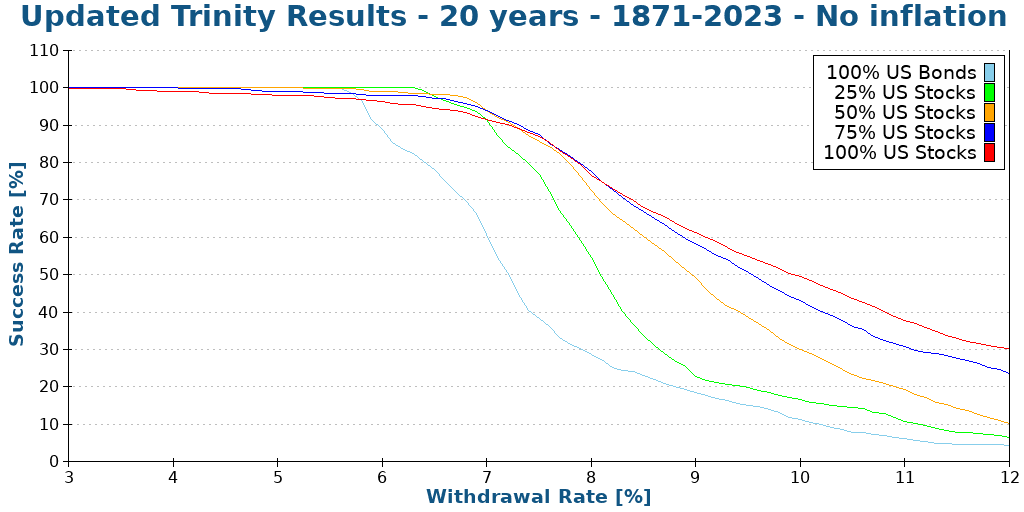
We can see what we already expect:
- Increasing the withdrawal rate decreases the chances of success
- Any withdrawal rate higher than 8% does not make sense long-term, even without inflation.
- A small allocation of bonds can help with lower withdrawal rates
- Generally, a 100% stock portfolio will perform better than the other portfolios.
Here is what happens when we push the simulation to 30 years.
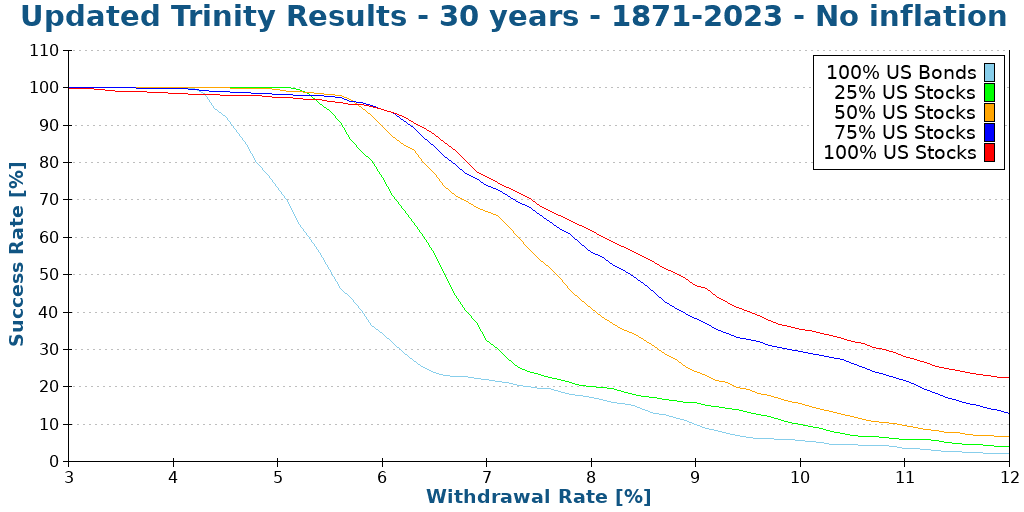
We can see that increasing the number of years decreases the likelihood of success. It is logical since you are more likely to run out of money.
With 30 years of retirement without inflation, a 6% withdrawal rate with a significant allocation to stocks still makes a lot of sense!
Taking Inflation into Account for retirement
However, it is much better to consider inflation in our simulation! We see again with 20 years to compare the results:
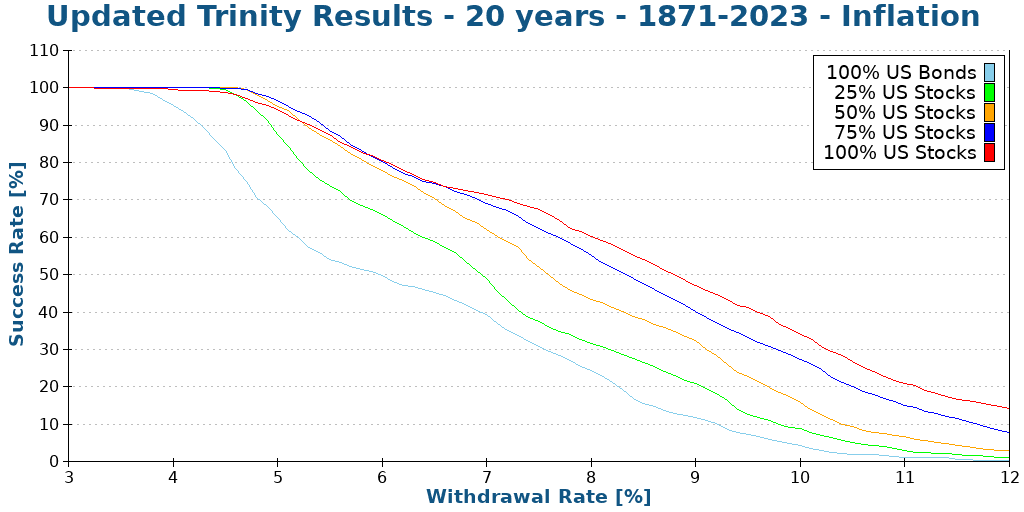
As we can see, inflation causes a significant hit to our chances of success! Before inflation, an 8% withdrawal rate made some sense. Now 6% is the limit. And even 6% has a barely over 75% chance of success!
Here is what happens in 30 years.
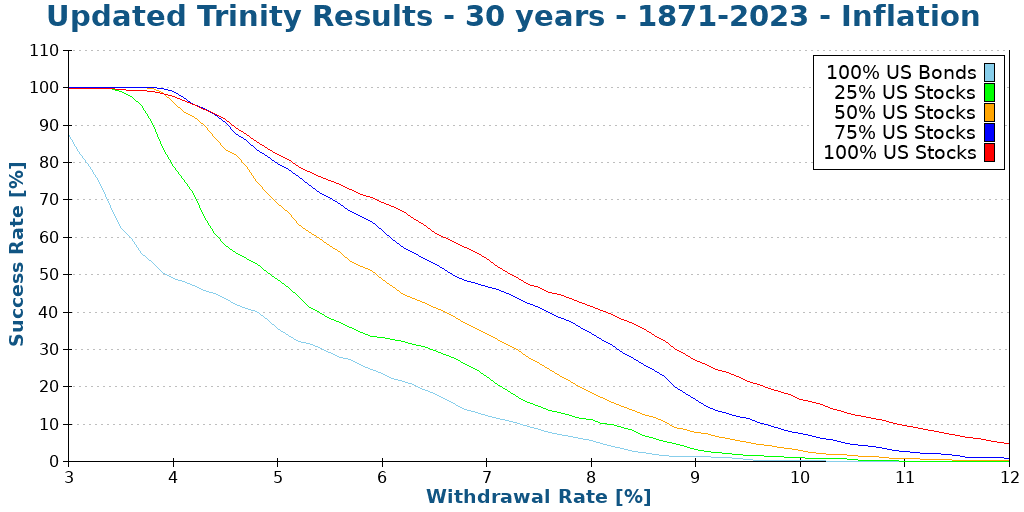
We can now see that anything higher than a 6% withdrawal rate is hazardous, with a less than 75% chance to succeed even with 100% stocks.
More withdrawal rates
Since we see that reasonable withdrawal rates are in the range of 3% to 6%, we try more withdrawal rates. I have simulated increments of 0.1% of withdrawal rates.
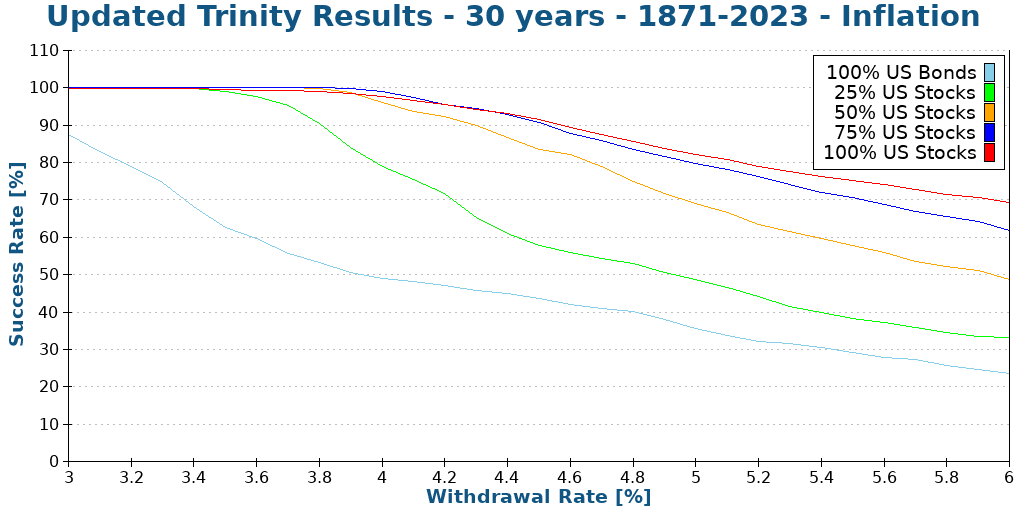
With a large stock allocation, withdrawal rates between 3% and 4% are very safe. Some people would even dare use withdrawal rates of about 4.5%. But even a portfolio with 100% stocks has only an 85% chance of success after 30 years with 4.5%.
Longer retirement time
One of the caveats of the original study is that they stopped at 30 years. We run the same simulation again but with 40 years this time.
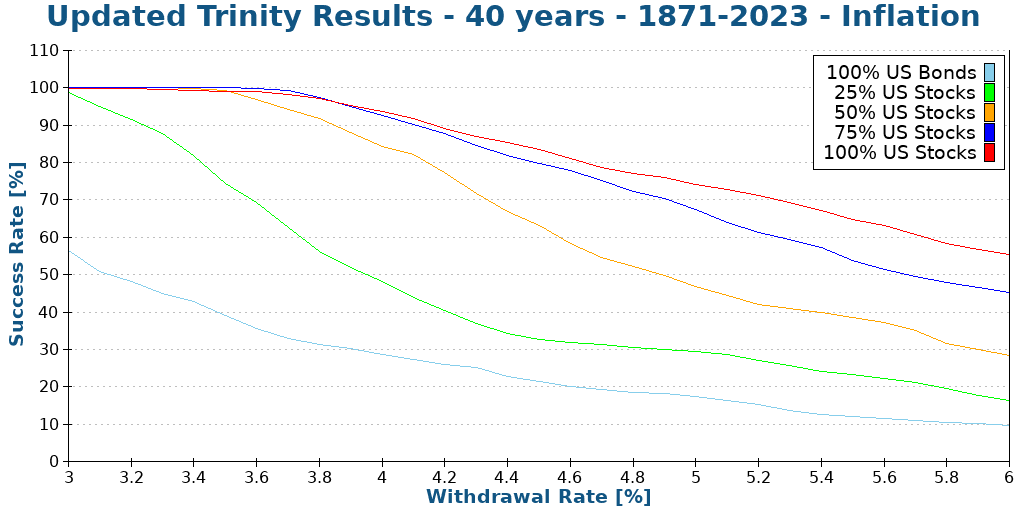
After 40 years, we are starting to see lower success rates, even for most people’s 4% withdrawal rate. Unless you have 100% of stocks, your success rate will be less than 90%.
Here is what happens with 50 years.
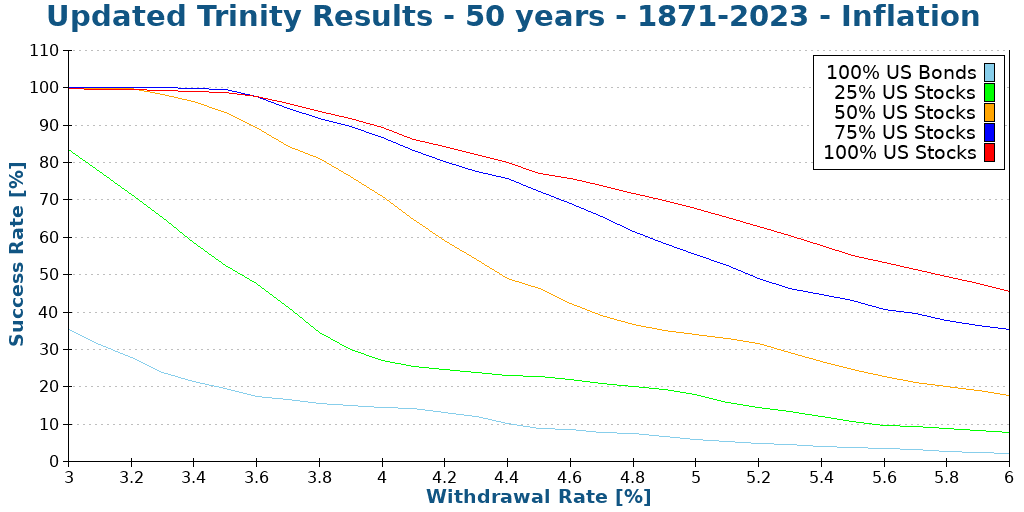
As expected, we see lower success rates. But it is still not bad at all with reasonable withdrawal rates. A 100% allocation to stocks and a 3.5% withdrawal rate still have more than a 98% success rate. This is significantly more than I expected.
It shows that the study’s original conclusion can still hold for over 30 years. It is excellent news!
Updated Terminal Values
Another interesting thing from the study was that they also compared the terminal values of the different withdrawal rates and portfolios.
So we will see the terminal values of a 1000$ portfolio after 30 years. I did the simulation for a portfolio of 100% Stocks. For the sake of display, I have reduced the number of withdrawal rates.
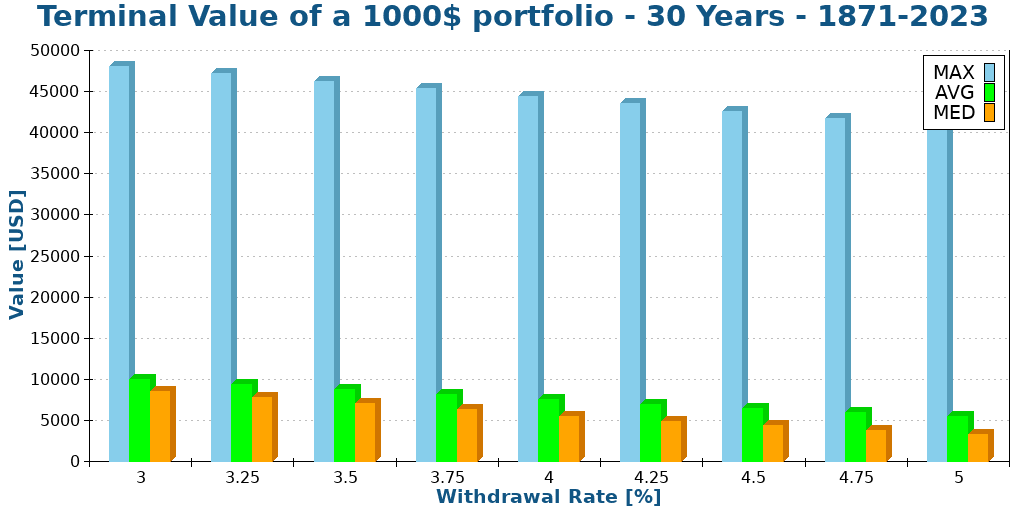
I did not show the minimum values. Indeed, they are always zero. If the chance of failure exceeds zero, the minimum value will be zero.
However, the average and median values are quite remarkable. We will focus on the median since it is generally more representative than the average.
For a withdrawal rate of 3.5%, my current target, the median terminal value after 30 years, is about 6700 dollars! Not only did your portfolio sustain your lifestyle, but it also increased six-fold! Let me repeat this. After 30 years of doing nothing but withdrawing money, you have six times more money than when you started!
The maximum values do not mean a lot. But it is crazy to see that after 30 years, you could have about 30 times more money than when you started! And this is with a 3.5% withdrawal rate!
Here is what happens when we extend it to 40 years.
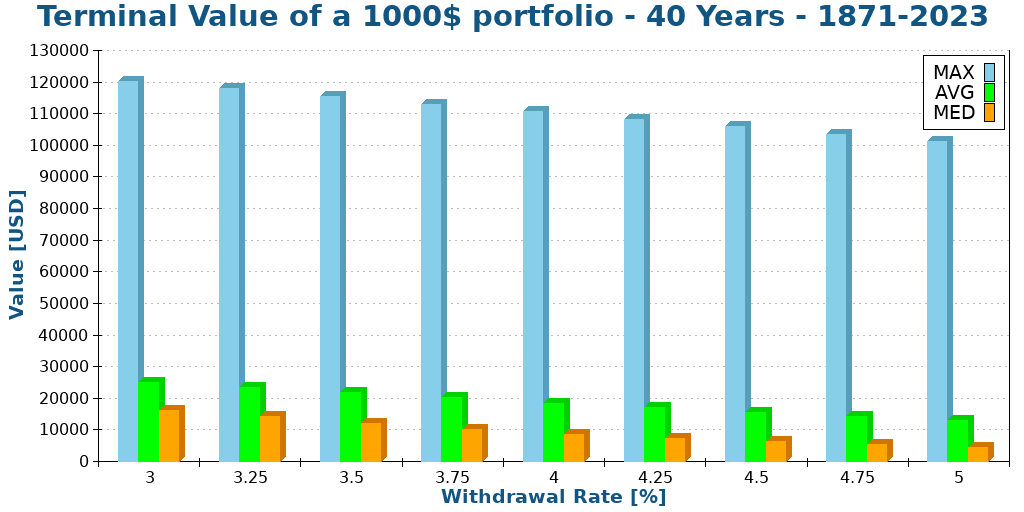
We can see that the results are comparable. However, all the values are significantly higher. The numbers are all about twice higher. On average, your retirement money will double during the ten additional years. So, even though you are not contributing more money and living from it, your portfolio will double in 10 years. How cool does that sound?
The success rate is not everything
There is something important with these measurements: the success rate does not tell the entire story. For instance, for you, which of these two scenarios is better:
- 98% to last 50 years, but a chance of running out after ten years
- 96% to last 50 years, but a chance of running out after 48 years
For me, the second scenario is better. You do not want to have a chance of failing after only ten years if you are planning for 50 years. But if it fails after 48 years, you have many years to make some adaptations.
So, another quite important metric is the worst duration of a scenario. This means after how many months, the first failure can happen.
For reference, here are the success rates of each portfolio for 50 years and different withdrawal rates:

And now, here are the worst durations for each of these portfolios:
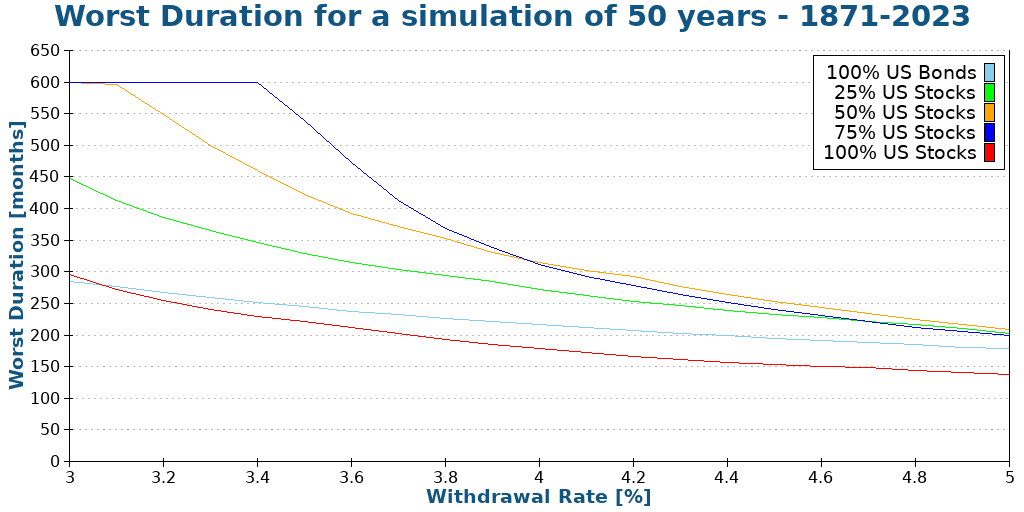
If we only look at the first graph, the conclusion is that higher allocation to stocks is always better. But if we look at the second graph, 100% stocks is the worst one!
So what does this mean: you need a balance in your portfolio. Bonds will significantly reduce the chances of your portfolio failing too early. This does not mean that you should optimize for the highest worst duration either. Because if your highest duration is 40 years, but you have only a 50% chance of reaching 50 years, this is gambling, not planning.
So balance is essential. While stocks will increase your success, stocks are more subject to sequences of return risks.
How to implement the Trinity Study?
Now that we have seen that the results of the Trinity Study are encouraging and would let people retire early, how should we implement it?
Theoretically, the Trinity Study is based on a simple concept: you can retire based on a large principal by withdrawing with a fixed withdrawal rate.
However, in practice, this means you need to accumulate money, more than most people accumulate during their lifetime. And you need to accumulate this earlier than retirement age.
To accumulate this money is not easy, but it is also not complicated. First, you need to save money (as much as possible). For this, you will need to focus on your expenses and earnings.
Then, you will need to invest that money until you can retire. Once you have accumulated the proper amount through capital gains and savings, you will be financially free.
If you are interested, I have many articles on my blog about financial independence.
How did I do it?
You can find my code and my data on Github. Everything is available to share as much as possible!
I wrote the entire program in C++. I used this programming language because it is my favorite! And it is blazing fast! I have not especially optimized my code, and it takes less than a second to generate thousands of simulations.
If you are not a coder, I also have an online FIRE calculator to do most of the calculations presented here.
My U.S. and international data is based on the data made available by Big ERN in its Safe Withdrawal Rate series. It is a good dataset that has been tested several times already. Big ERN made all this available for free. I am very thankful for his work! I have completed its data with the missing years using the same methodology.
If you want to use the graphs in this article, please cite this article as the source of the image!
Future of the series
It was fascinating to reproduce these results. And it was very insightful as well. I have learned many things from the results. It is great to see the confirmation that the original conclusions hold for more than 50 years.
And it also shows that my withdrawal rate (3.5%) is a safe bet. I may switch to 3.75% in the future. I will have to run more simulations. It is important to choose a proper safe withdrawal rate.
Talking of simulations, I have run a few more simulations with the same idea:
- Trinity Study Results with Swiss Stocks
- Withdrawal rates and low-yield bonds
- When should you rebalance your portfolio?
- Does the Trinity Study work in recent years?
- How often should you withdraw money?
Since I plan to make more articles like these with more simulations, I would like to get your point of view on this article! Please let me know what you think in the comments below! What should I improve?
What do you think of these results? Would you like me to run more simulations like this? Do you have ideas on what kind of simulations I should run next?
Conclusions
With all these results, we can have several important conclusions.
First, the paper’s original conclusions still hold even with much more data being considered. And it still stands accurate up to 2024! It is excellent since it shows that the 4% rule of thumb still works!
If you increase the simulation time to more than 30 years, a 4% withdrawal rate is no longer safe. With 50 years of retirement, you have a 90% chance of success with a 4% withdrawal rate at most. A withdrawal rate of around 3.5% would be safer for most people.
If you want real chances of success, you will need more than 50% of your portfolio allocated to stocks. The stocks allow us to fight inflation and cover the withdrawal rate year after year.
If you choose a reasonable withdrawal rate, you will likely have much more money than when you started! For instance, a 3.5% withdrawal rate over 30 years with 100% stocks would leave you about six times more money than when you started!
For information about the original study, read my detailed article about the Trinity Study. If you are extremely conservative, you will also be interested in learning how to choose a failsafe withdrawal rate.
If you want to start investing to become Financially Independent, you will be interested in my guide on how to get started in the stock market.
Download this e-book and optimize your finances and save money by using the best financial services available in Switzerland!
Download The FREE e-bookRecommended reading
- More articles about Financial Independence and Retire Early
- More articles about Retirement
- How to choose a Safe Withdrawal Rate?
- Equity Glidepaths in Retirement
- A Free FIRE Calculator – Find your chance of success

Hi Baptiste,
I understand that your research based on static historical data. You assume that market will behave as it has been behaving during last 150 years.
But.. Market has a habit to surprise investors with short/long term behaviour.
1. Did you make Monte Carlo change on market return? What are borders for the failure?
2. How and at which point you will decide that the plan to withdraw 3.5% doesn’t work any more?
3. Did check the system on other data, English, Holand stock/bond exchanges or other financial assets for example real estate?
Hi Boris,
Of course, the markets could surprise us, but I believe 150 years is a good enough sample, going through two world wars, several other wars, a cold war and plenty of recessions.
1) I never did and I won’t do
2) If you think the plan will never work, you will need to reduce the withdrawal rate before retirement. And you should plan for some margin of safety.
3) I did with Swiss stocks: The 4% Rule for Swiss Stocks – Can you retire early?. The problem is not running simulations, the problem is gathering good monthly data.
Hi Baptiste
Thank you for the great review. Super interesting to the see the probability of success of each strategy.
However, could you please explain how you extrapolate your historical data for the upcoming 30-50 years? Or are the results purely based on historical performance?
I would be up interested in knowing “what is a good year to retire” as the market situation in initial years of retirement should have a major effect in your portfolio for the future (eg. probably retiring in 2007/2008 would have smashed your capital in half). How do you see this risk?
Hi Vini,
Everything is based on historical data, I am not doing any extrapolation.
The best years to retire are at the beginning of a bull market or end of a bear market because you would soon profit from a long bull market and your portfolio would start low.
The worst years are at the top of a bull market.
But obviously, this is impossible to know where we are.
Thanks for the feedback!
So, once you reach the retirement age, would you rather invest the money coming from vb/3a through IBKR after pulling it out, or live of it for some years, not withdrawing anything from the IBKR during that period?
Do you think it makes any difference for the overall portfolio and WR?
I think it would depend on which asset performs better during a given year, right?
On another note, would you say it is beneficial to open a 3a account and invest in some less aggressive portfolio, to balance the volatility during retirement, or just simply do five 3a accounts, 99-100% in stock, and balance it by purchasing some more stable assets via IBKR as you go?
Cheers!
Hi Xanoso,
Keep in mind that the trinity study assumes that your money is always invested. I would personally move the money directly from my vb/3a to IB once I can.
I have an article about cash cushion in retirement.
As for your second question, I think it does not matter. Having bonds in your IB portfolio or in your 3a makes little difference. The important is that your overall allocation (accross your entire net worth) matches your asset allocation.
Hi Baptiste,
Thank you for your posts, Very inspiring research.
I want to verify the conclusion that could be made.
1. As long as we are becoming older (and further life years reduce) we can adjust our withdrawal rate (w.r.).
2. If during of our retirement period, if by any case our portfolio rose, we will be able to adjust withdrawal rate?
3. IF yes and both questions above, We can half retire early (60 years before end of life), with lower withdrawal rate ( for instance 2.5%), and each 5-7 years check to increase it depend on portfolio value, am I right?
thanks
Hi Boris,
1) It depends. Before retirement, you can always adapt your withdrawal rate and indeed, for a shorter retirement period, you can get a higher withdrawal rate. But after retirement, you cannot simply increase your withdrawal rate, that’s not how the simulation works.
2) You can always decrease the withdrawal rate. But increasing it will increase the risk and in retirement you do not have much ability to change it.
3) It’s true that you could increase your withdrawal rate if previous years have been good. But you have to be really careful about one thing: If you want to be flexible, you need to be flexible in both directions: lower and higher WR. And most people are incapable of scaling down their expenses (even though they think the contrary).
Hi, there,
How would you account for the 2nd and 3rd pillar in your net worth?
I understand you do take them into account, however, if you retire at 50, you will still need to wait ~10 years to touch it, so ultimately, the withdrawal rate from your IBKR portfolio will be greater during that time.
Do you exclude the funds from those in your net worth/withdrawal portfolio, or simply assume that during the first years you will burn faster your IBKR portfolio, and once you can touch 3rd pilar, you will use that instead of directly selling stock, and at ~65 you will start selling from IBKR again?
I wonder what your thoughts are on this aspect.
Cheers!
Hi Xanoso
It depends on how early I can retire. If I retire 10 years before retirement age, I would account for it since I would still touch it “soon”. If I retire 30 years before retirement age, I would not consider it in my net worth since it would not play an important role.
The withdrawal rate on IBKR would be greater, but my overall Withdrawal is what matters.
Once you get your vested benefits / 3a, you can transfer the amount to IB and this will lower your “IBKR WR”.
Thanks for the excellent article and research. My portfolio and expenses are such that I plan to take 4.5% withdrawals (4.5% of total portfolio at retirement) per year and never adjust for inflation. If I’m reading your results correctly, this withdrawal rate should be fine for 30+ years since it we will not be increasing the amount of the withdrawal.
Hi,
If you are not adjusting for inflation, you should be fine with 4.5% indeed.
However, you are taking more risks since you cannot grow your expenses. What if inflation is 3%-5% a year during your retirement?
Many thanks, that is really an excellent post.
When I personally think about withdrawal rates, stock/bond allocations and expected returns, I am always considering (i) the dividend yield of my portfolio and if the stocks have a strong dividend track record, solid business model and low or reasonable payout ratio then this should cover to a certain extent my withdrawal need, (ii) a cash buffer of ideally 3-5 years of withdrawal need which gets currently in Europe maybe 2% interest, so that in case of a significant stock market downturn, I can live off for 3-5 years of this cash buffer (and the dividends, that will hopefully will be paid out even during downturn) to avoid selling stocks at low prices and (iii) because of these considerations allocation basically everything to stocks plus cash and leaving out bonds, to benefit from return potential of stocks while buffering downturns with cash. Does that make sense from your point of view? Have you run any simulation with cash buffers or a special consideration of dividends with total shareholder return?
Would be very interested in opinions around these topics!
Many thanks again for this great article.
Hi Joe,
I think your points make sense indeed. Dividends will definitely help in not selling stocks. And a cash buffer will also help in a down turn. You just have to be careful that 3-5 years of expense in cash has a huge opportunity cost. I would personally not do that much.
I have an article that may interest you: Should you use a cash cushion in retirement?
As for dividends, I don’t have a particular article about them and retirement but I always said that they are important since they should cover at around half of the expense of our retirement in our plan.
Hi Baptiste,
Ben Felix discussed the “4% rule” in the Rational Reminder podcast recently.
https://www.youtube.com/watch?v=Fny-pvZS-lo
Unfortunately, the results are not good for non-US markets.
Making similar analysis for about 30 big markets over the last century, the respective withdrawal rate drops to ~2.2%(!) on average.
Note that this corresponds to investments only in the domestic market. e.g. a Canadian invests only in Canada, an Italian only in Italian stocks/bonds etc.
With internationally diversified portfolio the withdrawal rate increases to about 2.8%. (with some asterisks due to lack of data)
They also discuss the “survival bias”, luck etc that greatly affect the performance of certain markets (e.g. US).
Very interesting to hear for example that an investor in 1920 wouldn’t be able to see/predict differences in returns from the US and Argentinian markets!!
I highly recommend watching this podcast.
Hi huskarl,
Thanks for sharing!
Indeed, if you only consider Swiss shares, for instance, the results are not good. You need a large allocation to internal stocks to make it work.
Even when fully diversified, then you enter the currency risks that may make your life significantly more difficult.
I have talked about this: The 4% Rule for Swiss Stocks – Can you retire early?
We definitely have to be more conservative in Switzerland and likely in most countries.
Very interesting and eloquent post. Thank you!
I am one year and a half into FIRE, 38 yrs old, 100% invested in stocks and my withdrawal rate is of about 5%. In fact, this year it may be ending up being 4.5% thanks to a receivable amount that was eventually paid to me.
One may think that the charts and figures in this post do not account for taxes. In most countries, if we want to withdraw money from an investment portfolio we’re often subject to the capital gains tax. However, one can add the amount paid in taxes as part of the yearly expense. That is, as part of the withdrawn funds, and so have it accounted for as part of the withdrawal rate.
If I do this, my withdrawal rate might rise from 5% to 6%, which is dangerous territory for the sustainability of my FIRE plan. As said though, my withdrawal rate for 2022 will be closer to 4.5% than to 5%, and the taxes will be paid somewhere in 2023. Additionally, there’s another receivable amount that may materialise in 2023 of about 1% of my total net worth. So again for 2023 I may be able to reduce the withdrawal rate from 6% (taxes included) to 5%. But it’s soon to say as, at least for me, you don’t know exactly what your expenses for a given year will be. After this receivable that I expect to be paid in 2023, I will have no more receivables outstanding.
Thanks again for the post and good luck to everyone on a FIRE journey.
Hi Amat
Thanks for sharing!
Aren’t you worried with a 5% withdrawal rate and a long retirement time? Are your talking about your initial withdrawal rate or your current effective withdrawal rate?
Indeed, I am also accounting (like you!) all the taxes in th expenses. This is what makes most sense since taxes will vary wildly from one individual to the other.
We do have an advantage in Switzerland in that we don’t pay capital gain taxes (generally).
Good luck for your retirement, be careful about not being too aggressive.
Thanks Baptiste for your wishes.
Am I worried? Well, I am somewhat concerned that I won’t make ends meet somewhere down the line. This is why I live rather frugally and think, perhaps too wishfully, that I can beat the market at least in the following years, since my exposure is mostly to value stock and small-cap funds and I reckon these can outperform the market, if only for mean reversion reasons, after years where indices and growth stocks were the clear winners.
What I couldn’t afford was to keep working a job that, although well-paid, was sucking the life out of me. This is also a risk that often gets underestimated. That of living a life playing it safe and never jumping into the Grand Canyon. I FIREd to pursue my dream of being a music artist and yes, it’s quite a lean FIRE at the moment as per my withdrawal rate.
Initial and current withdrawal rate for me are pretty much the same thing as, since I said, I FIREd rather recently. 2022 has been my first full year on FIRE and so looking at my numbers I forecast 4.5% of my whole net worth will have been drawn by the end of the year. That does not include taxes to be paid in 2023 and, as said, I had an extraordinary income that lowered the withdrawal rate from my estimated 5% (ex-taxes) to 4.5%. I hope I understood your question correctly.
Oh right, you lucky Swissies! No capital gain tax would simply be wonderful for how I earn my living. I live in a big European capital because of the access to musicians and other people from the arts. And yea. Here taxes are high. If I was to play it safer I could relocate to a place with lower living costs. That’s for sure.
Good luck to you too.
Thanks for the details, you understood my question properly!
On the other hand, we have to pay significantly higher expenses than most neighboring countries, so there are not only advantages!
Good luck with FIRE!
Hi Baptiste
I really enjoyed reading this article. Good to know the 4% rule still applies in general!
I had a question though, as I am trying to understand how retirement withdrawals work. Currently I am contributing heavily every month to my IBKR account.
My plan is to invest around 500.000 CHF so that I can retire early to a country with low cost of living. When this time comes, how exactly do I withdraw from my brokerage account? Assuming I will expend 24.000 CHF a year, will I have to sell securities worth of 24.000 CHF each year in my IBKR account? Or is it possible to convert a normal brokerage account into a retirement account that can pay a fixed amount each month? I am a bit confused how it works exactly!
Thank you!
John
Hi John,
Thanks for your kind words :)
Good question. The idea of FIRE with a retirement portfolio is all based on selling stocks. Generally, you should sell as little as possible (use dividends first) and as late as possible (sell stocks monthly). You can’t convert an normal brokerage account into a retirement account. But there are ways to get a pension out of a lump sum, but these ways are generally reserved for very wealthy people.